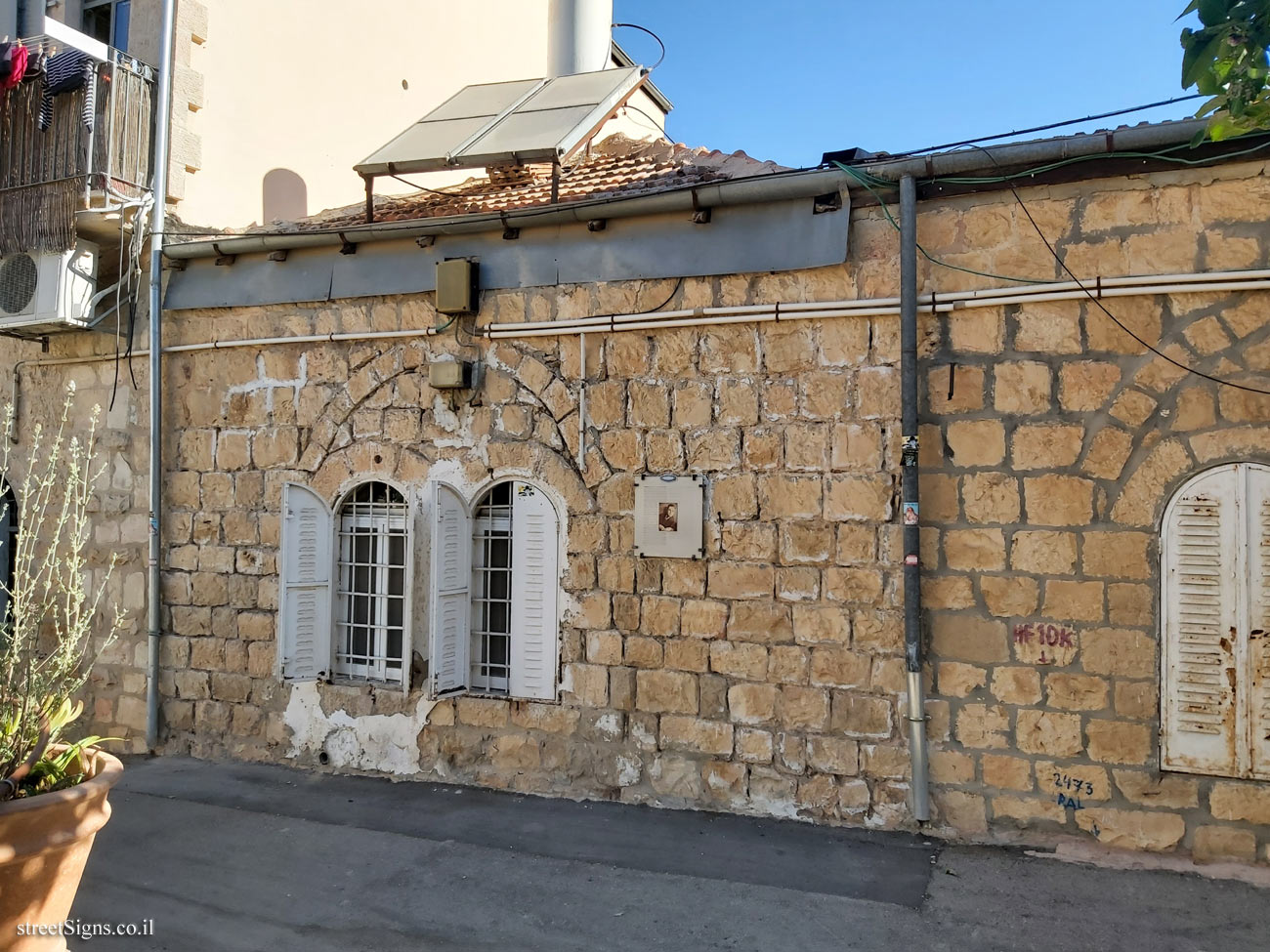On the sign:
סמל מיזם "תמונה באבן" - אוהל משה - תרמ"ב 1882 - ירושלים
המלחין יצחק לוי תרע"ט - תשכ"ז ( 1977-1919 ) האיר את היופי הגנוז בזמרת יהודי ספרד, הכרתיו מילדות. אנחנו שנינו מאותה שכונה בירושלים, "אוהל משה", שנינו שיחקנו ליד אותם בורות המים, אמותינו שרו לנו אותם שירי-ערש, התפללנו באותם בתי-כנסת: בית-הכנסת הגדול "אל קאל גרנדי", ובית-הכנסת הקטן עיש טרנטו "אל קאל צ’יקו", ולפעמים אצל יהודי יאנינה מיוון, "לוס נאניוטס". את כל חייו הקדיש להנצחת המורשת אשר ספג בבית אמו ובבית-הכנסת.
מי שלא ראה את יצחק לוי במלאכתו לא יבין משמעו של מי שממית עצמו באוהלה של תורה. הוא השקיע עצמו, ללא שיור, במפעל תרבותי אדיר, רב ממדים ועמוק השפעה: לדלות, לחשוף ולהאיר את היופי הגנוז בשירתם ובתפילתם של יהודי ספרד. יריעה רחבה פרש לפנינו: סלוניקי וטנג’ר, אמסטרדם וסרייבו, איזמיר, סופיה וקזבלנקה, וכמובן ירושלים. כיצד התפללו יהודים וכיצד שפכו צקון-לחשם לפני בורא עולם. מה המילים ומה הניגון. הוא היה מבוך ברשת הקוסמת של הפיוטים והלחנים, מסורת של דורות על גבי דורות, שעמדו כאבן שאין לה הופכין וכמעט נידונו לכליה. עמד והוציאם מן המחשכים, הסיר את האבק מעל פניהם והציגם באור יקרות בפני כול. פעמים בקולו עצמו, קול נאה להפליא ומרעיד לב, ולרוב על הכתב שורות שורות של מאות ואלפי עמודים ושרטוטי תווים מכלי-עיניים. האזין האזנה מתמדת ומייגעת לבעלי מסורות שאין השירה אומנותם. כמה אהבה ושקידה השקיע במעשיו! מה שבארצות אחרות טורחים ועושים מכונים ומוסדות ואפרטים שלמים עשה הוא יחידי, "מעולם לא ניצחני אלא בעל מלאכה אחת". אריח ועוד לבנה ועוד נדבך הלכו וגבהו לבנות ארמון רב תפארת. מה ששאל מן העם החזיר לו במנה כפולה ומכופלת, מעוטרת זיו והדר.
יצחק נבון
[תמונה של יצחק לוי]
[Image of Yitzhak Levy]
Symbol of the "Photograph in Stone" project - Ohel Moshe 1882 - JERUSALEM
Yitzhak Levy (1919-1977), the composer who illuminated the hidden beauty of the songs of Spanish Jewry. I knew him ever since I was a child. Both of us lived in Ohel Moshe, both of us played near the same water cisterns. Our mothers sang us the same lullabies, we prayed in the same synagogues: "El-Kal Grande", "El-Kal Chico" and sometimes "Los Naniotes". He dedicated his whole life to preserving the heritage he acquired in his mother’s home and in the synagogue. Whoever did not see Yitzhak Levy at work will not understand the meaning of a lifetime of dedication. He immersed himself unstintingly in a huge, immense, and greatly influential cultural project: to retrieve, uncover, and illuminate the hidden beauty of the songs and prayers of Spanish Jewry. He spread a wide canvas before us: Thessalonica and Tangier, Amsterdam and Sarajevo, Izmir, Sofia and Casablanca, and of course Jerusalem. How Jews prayed and poured out their hearts to the Creator, in what words and with which melodies. He was completely ensnared in the enthralling web of liturgical poems and melodies. He took the traditions of generations upon generations, which had been left like a stone unturned and almost doomed to oblivion, dusted them off, and placed them in the spotlight, for all to see. At times he did this in his own beautiful and exciting voice. How much love and assiduousness he put into his efforts! What in other countries is done by institutes and organizations he did all by himself. He placed brick upon brick until he erected a glorious palace. What he borrowed from the people he gave back to them twice and three times over, crowned in radiance and glory.
Yitzhak Navon
תרומת משפחת עוזי הלוי לזכר סבו החכם הרב בנימין הלוי
מינהל קהילתי לב העיר ירושלים
DONATE BY THE UZI HALEVY FAMILY IN MEMORY OF RABBI BINYAMIN HALEVY
LEV H’AIR COMMUNITY ADMINISTRATION

 Click for a larger image
Click for a larger image